You’ve tried out a few stand up paddleboards (SUPs), either borrowing from a friend or renting equipment. You’ve decided to take the plunge and commit to purchasing a SUP for you to call your own. But, now you need to determine whether or not to buy an inflatable or a rigid board.
WHICH ONE SHOULD YOU GET?
The short answer is: It depends. The long one: It depends on what you plan to use it for, how often you want to use it, and how much storage space you have? We can help you determine which type of board you should invest in.
DIFFERENCES IN PERFORMANCE BETWEEN INFLATABLES AND RIGID SUPS
Inflatable and rigid boards perform differently. Unless you are already familiar with the performance of “hard” boards such as surfboards, you will not likely notice the difference as a casual user. Overall, the pressure of a rigid board results in greater responsiveness, but this may not be a big deal depending on your needs. Some things to consider about performance versus riding style include:1. Long rides may feel more comfortable on an inflatable SUP compared to a rigid counterpart. General cruising will feel smoother on a rigid SUP, but may not be worth the loss in comfort to all riders.2. If you plan to surf, inflatable SUPs are less responsive, which may negatively affect your riding style.3. Racers or those who plan to do an incredibly long tour/endurance type rides will notice that inflatable SUPs experience more drag and do not reach as high of a speed compared to a rigid SUP.
DIFFERENCES IN CONSTRUCTION BETWEEN INFLATABLES AND RIGID SUPS
While inflatable and rigid SUPs perform the same tasks, they’re constructed incredibly different. There are four components to a rigid SUP while there are only three in an inflatable SUP. Due to differences in construction, rigid SUPs often have a higher volume, which translates to being able to support a higher weight in the water.
RIGID SUP CONSTRUCTION
- Top Coat: This is just a protective layer, usually made of something to protect the fiberglass beneath it.
- Deck: These are constructed of several layers of material. Decks usually contain fiberglass, but can also include wood, bamboo, kevlar, and even carbon fiber. Cheap boards have a foam deck, but unless you want to replace your board every season or two, those are best to avoid.
- Core: Cores are a foam material that is lightweight.
- Bottom: Usually several layers of fiberglass to protect the bottom of the board from damage.
INFLATABLE SUP CONSTRUCTION
- Top and Rails: These are constructed of military grade PVC, top coat, and other components that are sewn into other parts of the board to create what is essentially a small, whitewater raft-like craft.
- Core: Small fibers woven into the inside of the board that stand up and have significant tensile strength when the board is inflated. This is called drop-stitch technology, and the higher the drop stitch count, the better the board.
- Bottom: Made of a durable, hardened rubber material bonded together with the other board materials. This makes the board able to withstand the rough uses SUPs go through.
Performance and construction are just two small considerations when trying to figure out which style of SUP is best for you. While this may be enough information for you to make a decision already, we encourage you to check out part 2 of this article, where we discuss the pros and cons of each board style concerning travel, storage, and repairs.
If you have questions about what you’ve read so far today, please contact us at San Diego Surfing School today!
Alternatively, stop by the orange tent on the beach. We are always happy to share the stoke!






